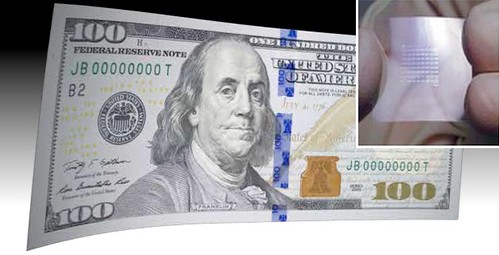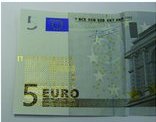
PREV ARTICLE
NEXT ARTICLE
FULL ISSUE
PREV FULL ISSUE
ORGANIC ELECTRONICS ON BANKNOTES: CAN CIRCUITS CIRCUMVENT COUNTERFEITS?
Dick Johnson's son Jeffry forwarded this item speculating on the use of cheap electronics as an anti-counterfeiting measure for currency.
-Editor
Banks and mints use a wide variety of methods to foil (as it were) attempts to print one's own money. Up to now, those methods have been essentially passive - fluorescent inks, foil strips, holograms and watermarks, to name but a few. Imagine how much more effective a deterrent to theft and counterfeiting a more active form of security would be. If banknotes could incorporate a transponder circuit, or a unique RFID tag, they could be tracked and identified wherever they went, and building a circuit into something as delicate as a banknote is far more difficult than setting up printing plates in your garage. But just how do you add circuitry to a banknote? Conventional electronics processing is too destructive, and conventional circuitry, even miniaturized as far as possible, is still far too large to be effectively useful. Enter the work of Ute Zschieschang and an international team from Germany and Japan. Using dry processing conditions (vacuum deposition) the team were able to pattern arrays of thin film transistors onto the surface of a 5-Euro note, and even build circuits using the transistors. Out of every 100 transistors deposited, 92 were operational, a more than good enough yield for the circuits to work reliably. Looks like your money is set to become a little bit safer.
To read the complete article, see:
Circuits Circumvent Counterfeit Currency
(www.materialsviews.com/details/news/961735/
To read the original research paper, see:
Organic Electronics on Banknotes
(onlinelibrary.wiley.com/doi/10.1002/
One of my favorite magazines, Fast Company, also published an article about this technology. Here are some excerpts.
-Editor
Cash counterfeiters have had a hell of a good run. Now the fakers may get a serious sprint for their money. The battle to make paper currency un-counterfeitable has already seen some cutting-edge science in action, but the latest efforts may be the highest-tech yet: Banknotes could soon get a layer of printed electronics, and wireless readability, to make faking essentially impossible. The new tech is coming out of research in Germany and Japan, and it involves our old future-tech friends--transparent, flexible microelectronics. The new research has seen a breakthrough in printing thin-film transistors out of a mix of gold, aluminum oxide, and organic molecules through a patterned mask (similar to how silicon chips are "printed" in layers) onto paper currency. The real trick has been to achieve the printing process without "aggressive chemicals or high temperatures," both of which could compromise or preclude other anti-counterfeit measures, or damage the actual paper of the notes themselves. The result is an array of around 100 organic transistors on each note's surface, each less than 250 nanometers thick and capable of turning on an off with just 3 volts of juice--the kind of power that can easily be transmitted over short ranges by wireless tech. In other words, the notes could be detected as real by passing them over similar detectors as the ones used in metro stations (and soon, many smartphones). As yet this research is in its infancy, but it's so very promising that it could easily find its way onto your cash sooner rather than later. Since you can build quite complicated electronic structures on the notes, the circuits are potentially capable of performing basic computations--meaning you could even encrypt an extra layer of protection into the design, which may tempt mints around the world to quickly embrace the idea. We've just gotta hope that the Federal Reserve, when it gets its hands on this tech, doesn't mess it up and cause another $100 billion printing error recall. Because that kind of mistake is expensive.

To read the complete article, see:
What Would You Do With a $100 Bill Covered by Invisible Transistors?
(www.fastcompany.com/1711656/invisible-printed- The Numismatic Bibliomania Society is a non-profit organization promoting numismatic literature. See our web site at coinbooks.org. To submit items for publication in The E-Sylum, write to the Editor at this address: whomren@gmail.com To subscribe go to: https://my.binhost.com/lists/listinfo/esylum All Rights Reserved. NBS Home Page Contact the NBS webmaster 
|
